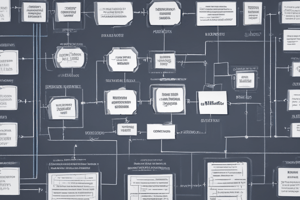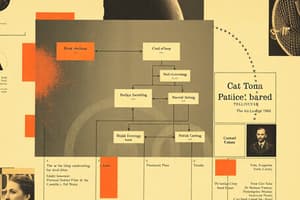Podcast
Questions and Answers
What is the primary purpose of a brief use case description?
What is the primary purpose of a brief use case description?
- To define the specific technical implementation details for a specific use case.
- To illustrate the interactions between users and the system using visual diagrams.
- To provide a detailed and comprehensive account of all system functionality.
- To summarize the main steps and data affected in a use case in a concise manner. (correct)
Which of the following is NOT typically included in a brief use case description?
Which of the following is NOT typically included in a brief use case description?
- The intended action of the user.
- The data that is affected internally.
- The actor performing the action.
- The technical details of system implementation. (correct)
What is the term used for an end user in Unified Modeling Language (UML)?
What is the term used for an end user in Unified Modeling Language (UML)?
- Actor (correct)
- Operator
- Administrator
- User
What does the automation boundary represent in a use case diagram?
What does the automation boundary represent in a use case diagram?
What is the standard for diagrams and terminology used in developing information systems?
What is the standard for diagrams and terminology used in developing information systems?
Which of the following is the most accurate description of a use case diagram?
Which of the following is the most accurate description of a use case diagram?
Why is it important to create use case diagrams for each subsystem?
Why is it important to create use case diagrams for each subsystem?
According to the content, what is the purpose of documenting use cases?
According to the content, what is the purpose of documenting use cases?
What is the primary purpose of the 'include' relationship in use case diagrams?
What is the primary purpose of the 'include' relationship in use case diagrams?
In the example of 'Make a Purchase' and 'View Shopping Cart' use cases, why is 'Calculate Total Price' included as a separate use case?
In the example of 'Make a Purchase' and 'View Shopping Cart' use cases, why is 'Calculate Total Price' included as a separate use case?
How is the 'include' relationship visually represented in a use case diagram?
How is the 'include' relationship visually represented in a use case diagram?
Which of these use cases is likely to be included within the 'Checkout' use case, based on the given examples?
Which of these use cases is likely to be included within the 'Checkout' use case, based on the given examples?
Which of the following is NOT a valid reason for using the 'include' relationship in use case diagrams?
Which of the following is NOT a valid reason for using the 'include' relationship in use case diagrams?
The 'include' relationship is a way to modularize and reuse common functionalities across different use cases. What other aspect of the use case diagram's purpose does this illustrate?
The 'include' relationship is a way to modularize and reuse common functionalities across different use cases. What other aspect of the use case diagram's purpose does this illustrate?
Based on the examples provided in the content, which of these use cases would most likely be included in the 'View Shopping Cart' use case?
Based on the examples provided in the content, which of these use cases would most likely be included in the 'View Shopping Cart' use case?
Flashcards
Use Case
Use Case
A description of how users interact with a system to achieve a goal.
Brief Use Case Description
Brief Use Case Description
A one-sentence description highlighting main steps in a use case.
UML
UML
Unified Modeling Language; standard for diagramming information systems.
Actor
Actor
Signup and view all the flashcards
Automation Boundary
Automation Boundary
Signup and view all the flashcards
Use Case Diagram
Use Case Diagram
Signup and view all the flashcards
Subsystem
Subsystem
Signup and view all the flashcards
Fully Developed Use Case
Fully Developed Use Case
Signup and view all the flashcards
Diagram
Diagram
Signup and view all the flashcards
Include Relationship
Include Relationship
Signup and view all the flashcards
Main Use Case
Main Use Case
Signup and view all the flashcards
Common Functionality
Common Functionality
Signup and view all the flashcards
Dashed Arrow in Diagrams
Dashed Arrow in Diagrams
Signup and view all the flashcards
Subroutine
Subroutine
Signup and view all the flashcards
Study Notes
Software Requirements Analysis and Design - Use Case Documentation and Modeling
- The course ACS2913 covers Software Requirements Analysis and Design, focusing on use case documentation and modeling.
- Use case descriptions are brief, one-sentence summaries of the main steps within a use case.
- Use cases provide detailed descriptions of how users interact with the system.
- These detailed descriptions will be covered later in the course.
- Use case descriptions detail the user's actions and the internal system effects.
Use Case Diagrams
- Use case diagrams are UML models graphically representing use cases and their links to actors.
- UML stands for Unified Modeling Language, the standard for diagrams and terminology used in information systems development.
- An actor represents an end-user.
- Automation boundary defines the system's computerized section, separating it from the users.
Use Case Diagram Symbols
- Actors are depicted as stick figures, representing actual people interacting with the system.
- Connecting lines show which actors are involved in specific use cases.
- Rectangles represent the system's automated boundaries.
Use Case Diagrams Draw for Each Subsystem
- Draw a use case diagram for each subsystem.
- Actors: Customer, Customer service representative, Store sales representative, Management, and other relevant roles.
Include Relationship
- The <> relationship in a use case diagram is a way to reuse common functionalities across different use cases.
- It's a way of modularizing and simplifying the design.
- Example: For both "Make a Purchase" and "View Shopping Cart" use cases, the "Calculate Total Price" use case can be included to avoid duplication.
More <> Examples
- Checkout use case consists of several use cases such as Scan Item, Calculate Total & Tax, and Payment.
- Deposit Funds and Withdraw Cash have Customer Authentication as a included use case.
Use Case Diagrams: Steps
- To create a use case diagram, identify all stakeholders and users.
- Determine what each stakeholder or user needs to review in a use case diagram: each subsystem, for each type of user, relevant use cases
- Select relevant use cases and actors and draw the use case diagram for communication needs
- Draw the use case diagram, carefully naming each element.
- Specify how and when to review the use case diagram with stakeholders and users.
Studying That Suits You
Use AI to generate personalized quizzes and flashcards to suit your learning preferences.




